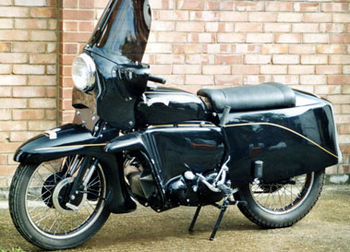Vincent Black Prince
1950 was marked by a high point in sales for the Vincent marque with 2800 examples leaving the factory, however, by 1953 sales had fallen to a little over 450 machines. This decline in sales was responsible fro the development of the Black Prince and its sister machines the Black Knight and Victor single.
The company recognized that the technological advantage that their products had enjoyed for a number of years was being eroded. Rear suspension had become common place with all of the major manufacturers offering it in one form or another, electrical systems had improved greatly and the introduction of 650cc twins had blunted the Vincent's performance advantage. Further compounding the problem was the increasingly dated styling of the Stevenage product when compared to the integrated appearance of the products emanating from Meriden, Bracebridge Street and Small Heath, which were also considerably cheaper.
Phil Vincent recognised the need to revise the range but sought to do so in such a way that would maintain the Vincent's position as an innovative machine, built to an excellent standard appealing to the discerning rider.
The new machines would not simply be a refinement of the existing Series C range but would mark a radical change in direction for the Stevenage product. A number of mechanical refinements were introduced for the revised range and the electrical system was uprated to include a 60 watt dynamo, the components now being sourced from Lucas. Amal Monobloc carburettors replaced the remote float chamber items previously employed aiding starting and fuel economy; however, it was the decision to employ full enclosure that would define the Series D machines. The machines featured a full front mudguard and rear enclosure that hinged upwards to facilitate rear wheel removal. The sidepanels incorporating the legshields were mounted to integrated crash bars and were carefully shaped to channel air to the cylinders. A half fairing and screen incorporating a dashboard mounting a three inch Smiths speedometer completed the enclosure. Contempary road tests reported on the excellent weather protection provided and the consequent increase in rider comfort, however, the nature of the "snarling beast" was fundamentally altered.
